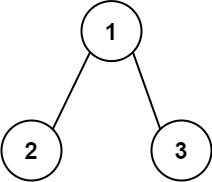You are given the root of a binary tree containing digits from 0 to 9 only.
Each root-to-leaf path in the tree represents a number.
- For example, the root-to-leaf path
1 -> 2 -> 3represents the number123.
Return the total sum of all root-to-leaf numbers. Test cases are generated so that the answer will fit in a 32-bit integer.
A leaf node is a node with no children.
Example 1:

Input: root = [1,2,3] Output: 25 Explanation: The root-to-leaf path1->2represents the number12. The root-to-leaf path1->3represents the number13. Therefore, sum = 12 + 13 =25.
Example 2:

Input: root = [4,9,0,5,1] Output: 1026 Explanation: The root-to-leaf path4->9->5represents the number 495. The root-to-leaf path4->9->1represents the number 491. The root-to-leaf path4->0represents the number 40. Therefore, sum = 495 + 491 + 40 =1026.
Constraints:
- The number of nodes in the tree is in the range
[1, 1000]. 0 <= Node.val <= 9- The depth of the tree will not exceed
10.
Note: A leaf node has no children.
思路不是很清晰,先用一个最简单的方法。实现了,看看有什么问题需要注意的吧。
/*** Definition for a binary tree node.* struct TreeNode {* int val;* TreeNode *left;* TreeNode *right;* TreeNode() : val(0), left(nullptr), right(nullptr) {}* TreeNode(int x) : val(x), left(nullptr), right(nullptr) {}* TreeNode(int x, TreeNode *left, TreeNode *right) : val(x), left(left), right(right) {}* };*/class Solution {public:int sumNumbers(TreeNode* root) {int total = 0;helper(root, 0, total);return total;}private:void helper(TreeNode* root, int pre, int& total) {if (!root)return;if (!root->left && !root->right)total += pre * 10 + root->val;helper(root->left, pre * 10 + root->val, total);helper(root->right,pre * 10 + root->val, total);}};
----------------------------因此我们分别计算左右子树,再加起来,就accept了--------------------
public class Solution {
public int sumNumbers(TreeNode root) {
if (root == null) {
return 0;
}
return getSum(root, 0);
}
private int getSum(TreeNode node, int curSum) {
// return the new sum of the of the current
if (node.left == null && node.right == null) {// find leaf
return (node.val + curSum * 10);
}
int sumLeft =0, sumRight =0;
if (node.left != null) { // go further left
sumLeft = getSum(node.left, curSum * 10 + node.val);
}
if (node.right != null) {// go further left
sumRight = getSum(node.right, curSum * 10 + node.val);
}
return sumLeft + sumRight;
}
}
Mistakes:
1 : 思路不清晰。 刚开始走了弯路, 去生成新的tree去了。其实是不需要新的tree的。
当然,也可以在getSum()方法中,传递一个 preSum 参数,来记录前序节点的和。
Learned:
leetcode 中,添加了新的类变量,会导致一系列问题。
见买买提链接
use a data member.
and the result are accumulated...
I think your algorithm is right. But you use static vars, which might cause problem. Because maybe OJ just creates one instance of class solution, and uses it on many test cases. So you had better reset them. This is the only reason I can come up with. I am not sure. You can use a vector to track the node instead.
---------------1337
yes. that's the problem.
and i initialized it to 0 in the function and here we go.
【 在 stupidrobot (robot) 的大作中提到: 】
: 谨慎估计你添加新的类变量了
下面的解法,是不对的。Tiger 自己想想,是哪里不对了。
public class SumRootToLeafNumbers2 {
public int sumNumbers(TreeNode root) {
if (root == null) {
return 0;
}
return getSum(root, 0, 0);
}
private int getSum(TreeNode node, int totalSum, int curSum) {
// return the new sum of the of the current
if (node.left == null && node.right == null) {// find leaf
totalSum += (node.val + curSum * 10);
return totalSum;
}
if (node.left != null) { // go further left
totalSum += getSum(node.left, totalSum,curSum * 10 + node.val);
}
if (node.right != null) {
totalSum += getSum(node.right,totalSum, curSum * 10 + node.val);
}
return totalSum;
}
}
答案就在于,左右子树的结果,不应该是 totalSum += , 而仅仅 totalSum= 就可以了。
No comments:
Post a Comment